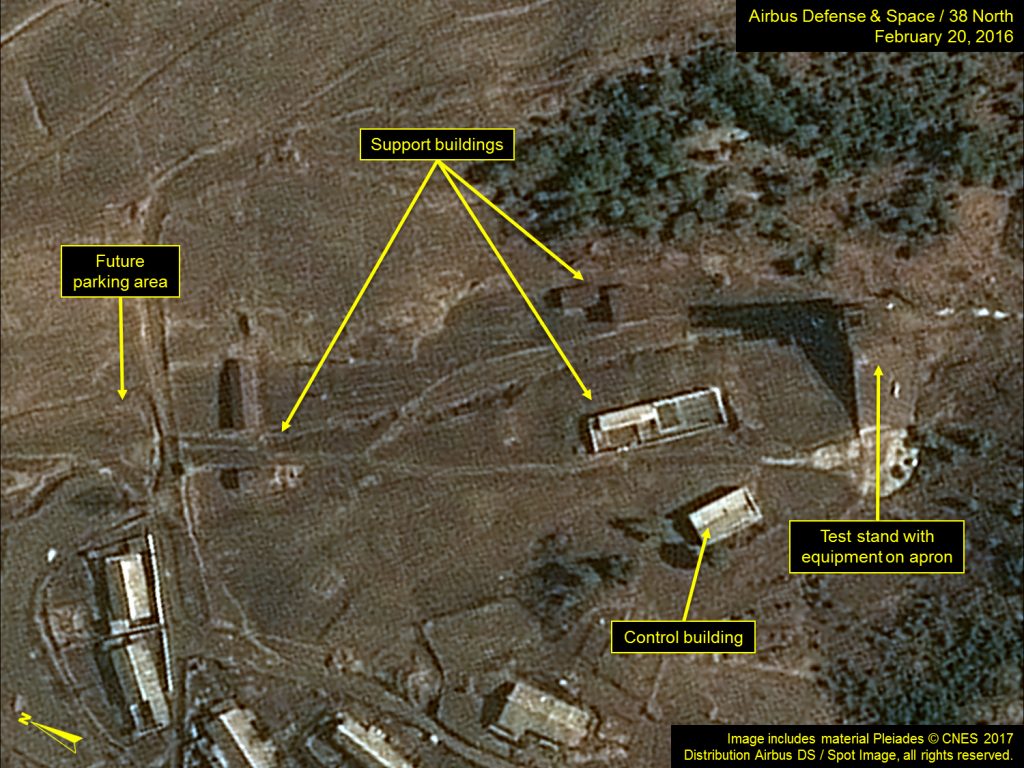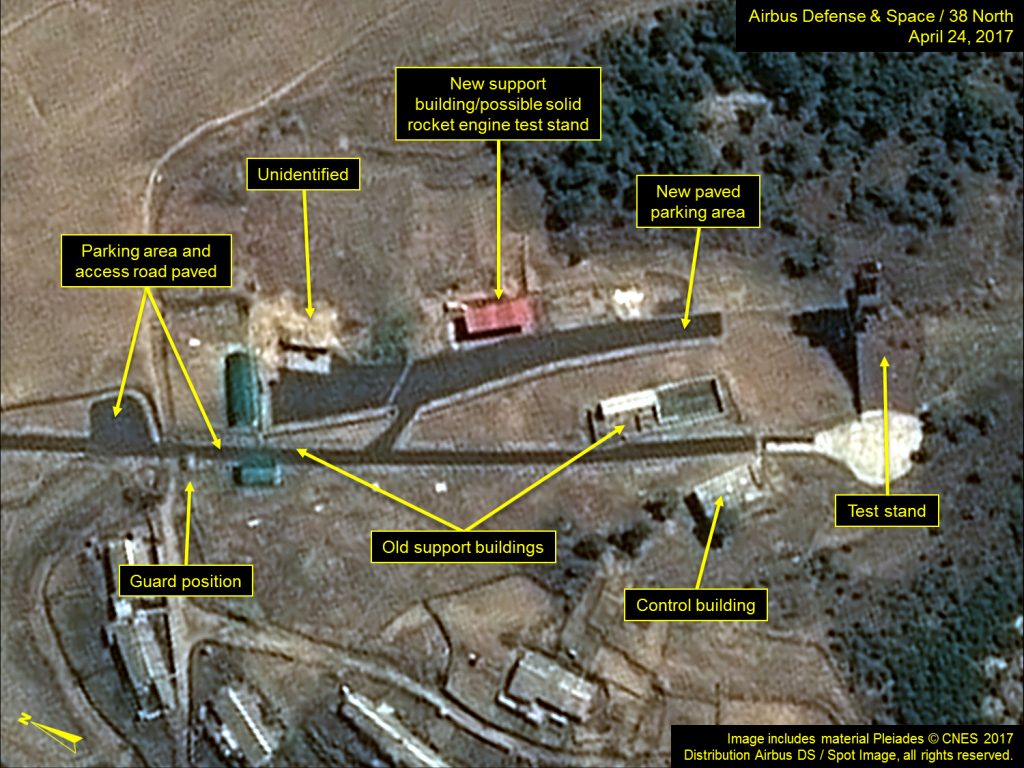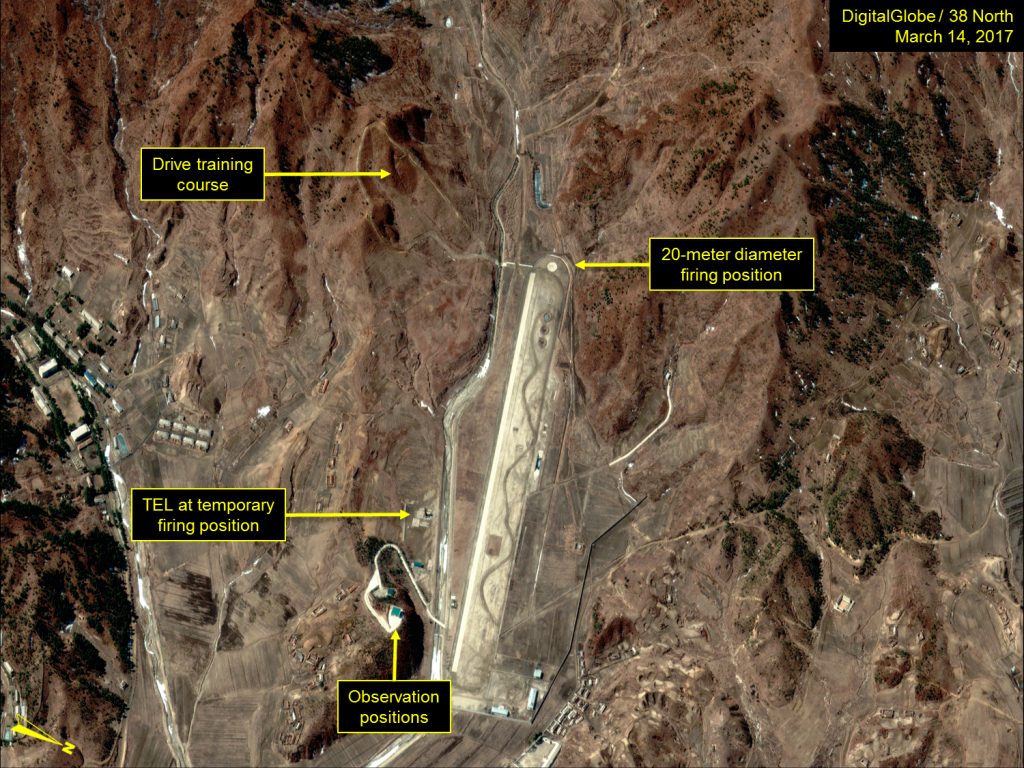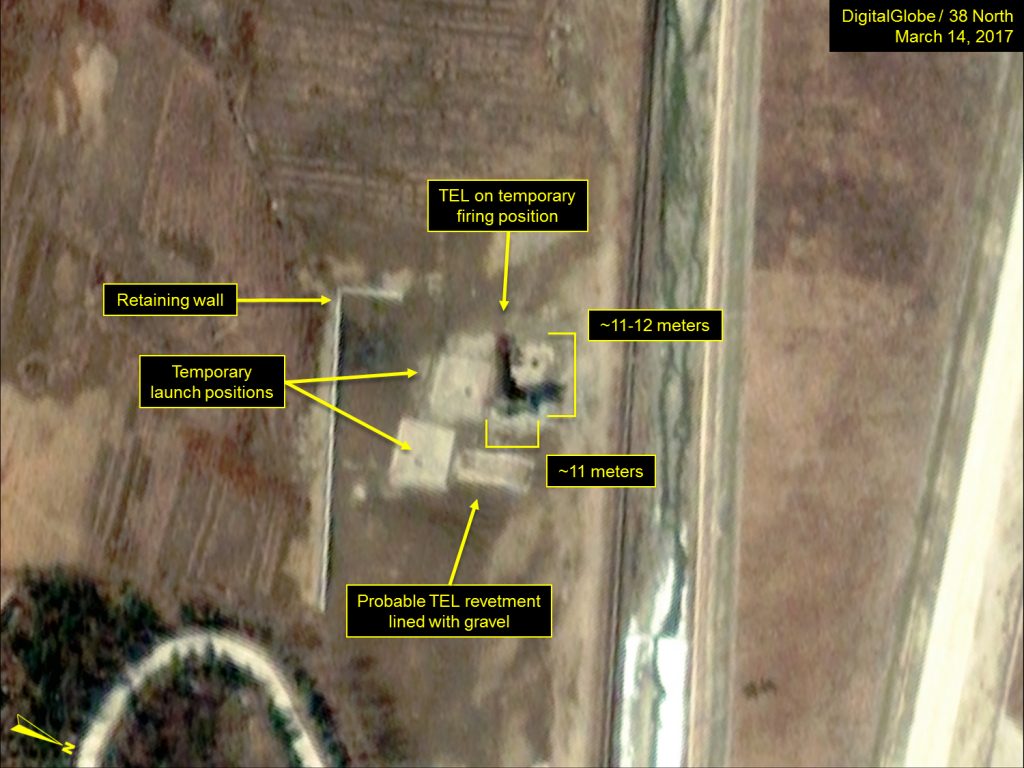New Developments in North Korea’s Ballistic Missile Infrastructure—What Does it Mean for the Future?
The massive military parades in Pyongyang provide great opportunities to gain insight into North Korea’s ballistic missile aspirations, but they are often used to disseminate propaganda and dissemble about its real aspirations and program direction. Rather than parades, infrastructure developments often provide the most accurate indicators and warnings of long-term program directions and capabilities. Some of the more notable examples that have not received the attention they deserved because of an excessive focus on the military parades include:
- The construction of two successive missile test stands from 2011-2014, which presaged the development of submarine-launched ballistic missiles (SLBMs) and an experimental ballistic missile submarine;
- The suspension, in 2013-2014, of a substantial modernization program[1] at the Tonghae Satellite Launching Ground, which foretold the concentration of limited resources into expanding and developing the Sohae Satellite Launching Station; and
- The beginning of construction on a solid rocket engine test facility at Magunpo in early 2013, which anticipated the development of large solid-fuel rocket engines (i.e., for the Pukguksong-1 SLBM and Pukguksong-2 medium-range ballistic missile (MRBM)), smaller air-to-air and air-to-ground class systems and potentially cruise missiles.
More recently, several infrastructure developments may provide new insights into future development in the North’s missile programs. Among these are:
Modernization of the vertical engine test stand facility at the Tae-sung Machine Factory: Commercial satellite imagery from February 20, 2016 and April 24, 2017 show that over the past year, a modernization program has begun at the Tae-sung Machine Factory’s vertical engine test stand facility.[2] Included among the activities noted here are the placing of a guard position at the entrance, paving of the access road and parking area, construction of a large new paved work yard and the replacing of several support buildings with new structures.
One of these new support structures is suggestive of a horizontal solid rocket engine test stand similar in size and layout to that seen at the Magunpo solid rocket engine test facility.[3] In March 2016, North Korea conducted a nose cone test at this site. That test along with the current modernization of this facility indicates its continuing role in more advanced ballistic missile design and development efforts. Should the new support building prove to be for solid rocket engine development and testing, it supports the analysis of an expanding effort in this field. It may also be related to the acquisition of the second submersible test stand barge and an expansion of SLBM developments to the West Sea area.
Figure 1. Vertical engine test stand at Tae-sung Machine Factory in February 2016.

Figure 2. Renovated Tae-sung Machine Factory in April 2017, with possible new solid rocket engine test stand.

Development of a new missile and TEL: On February 12, 2017, North Korea conducted its first test launch of its Pukguksong-2 MRBM from the Iha-ri Driver Training and Test Facility north of Kusong.[4] The choice of the Iha-ri facility was a logical one since the system’s transporter-erector-launcher (TEL) is manufactured at the nearby No. 95 Factory. Recent commercial satellite imagery shows that during January-April 2017, the North has constructed two temporary launch positions on the south side of the Iha-ri facility.[5] Significantly, satellite imagery from March 14, 2017 shows what also appears to be a TEL with launch tube elevated. The image is taken at a high off-nadir angle, which makes accurate measurement challenging, however, the elevated height of the launch tube is approximately 11-12 meters with a diameter of approximately 3 meters. The overall length of the tube and TEL is approximately 11 meters. These dimensions match neither the Pukguksong-2 TEL with launch tube, nor the new trailer-mounted ICBM TEL’s large launch tube.[6] Rather, taken as a whole, these developments suggest: an existing tracked Pukguksong-2 TEL with an, as yet unreported, missile system that has a larger diameter but is shorter than the systems displayed during the recent parade; an existing tracked Pukguksong-2 TEL with a missile training system; or an, as yet unreported, new TEL with a new missile system.
Figure 3. The Iha-ri Driver Training and Test Facility north of Kusong.

Figure 4. Close-up of TEL with launch tube elevated at the Iha-ri facility.

The Iha-ri Driver Training and Test Facility is likely being used for both manufacturer’s tests and acceptance trials for the Pukguksong-2 and other TELs. Moreover, Iha-ri is likely being used as a temporary training facility for launch crews.
Additionally, the February 12 Pukguksong-2 test and April 15 parade indicate that the tracked TEL will likely form the basis for the first Pukguksong-2 missile brigade and that tracked or trailer TELs will likely form the basis for larger missile systems under development. The 2017 appearance of several indigenously designed and constructed tracked TELs—based upon a common parent chassis rather than more efficient multi-axle wheeled TELs—strongly suggests that international pressure on China to restrict sale of large, heavy-duty dual-use trucks to North Korea has had an effect upon the North’s ballistic missile program.
————–
[1] This modernization program included construction of a new launch pad, horizontal processing building, administration and launch control building and substantial road and housing improvements.
[2] The Tae-sung Machine Factory is sometimes identified as the Chamjin-ri or Sagi-dong Missile Factory. This is North Korea’s oldest ballistic missile production complex.
[3] The dimensions of the Magunpo test stand are 16.25-meters by 8.25-meters, while the new structure at Tae-sung is approximately 16.25-meters by 6.25- meters. The structure at Tae-sung, however, does not presently have an exhaust trench.
[4] Although the Iha-ri area has long been used for tank and armored fighting vehicle testing and driver training it wasn’t until late-2014 that an actual facility and formal driving course was constructed. Although there is a 20-meter in diameter paved firing position on the west side of the facility suitable for training Pukguksong-2 TEL crews and launching the missile, North Korea elected to use the main driving training course for its February 2017 test launch of the system.
[5] Each position consists of a square dirt pad (approximately 13-meters by 12.5-meters and approximately 13.75-meters by 13.5-meters) and a rectangular firing position approximately 17-meters by 4-meters).
[6] The author would like to thank Nathan J. Hunt for sharing some of his preliminary dimensional data of the new canister missile systems displayed during the April 15, 2017 military parade.
